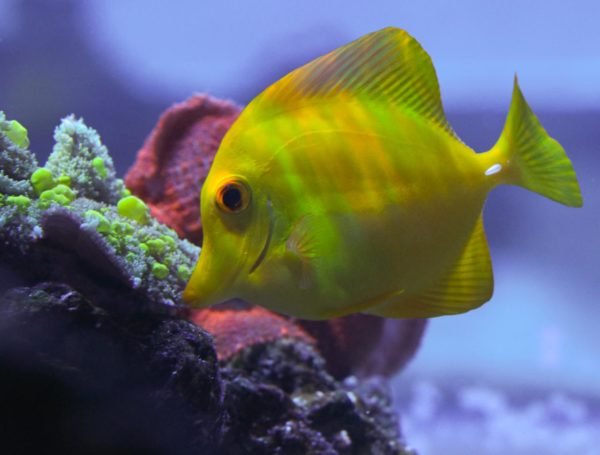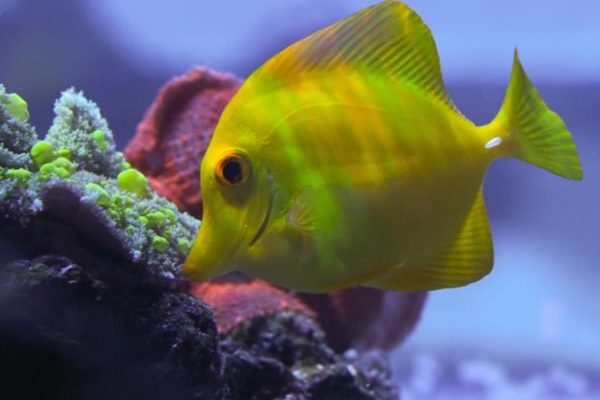
Picture this: you have a beautiful aquarium set up, and you’re excited about adding that splash of yellow. Before you rush to the store, it’s vital to grasp what makes these fish tick. Yellow Tangs are not just pretty; they have specific requirements when it comes to tank size, water quality, and diet. With the right care, your Yellow Tang can live for years, bringing life to your aquarium and becoming a favorite among your household.
Understanding the Yellow Tang
Before diving into care specifics, let’s get to know our shimmering friend a little better. Yellow Tangs, scientifically known as *Zebrasoma flavescens*, hail from the warm waters of the Pacific Ocean, particularly around Hawaii. In nature, they swim in schools and graze on algae, which plays a crucial role in their diet and behavior.
Honestly, understanding their natural habitat helps you recreate a similar environment in your aquarium. Yellow Tangs thrive in well-structured aquascapes with plenty of hiding spots and open swimming spaces. They’re social creatures and do best when they can interact with other fish. So, don’t be surprised if you find your Yellow Tang curious about its tank mates!
Setting Up the Perfect Aquarium
When you’re ready to house a Yellow Tang, the first step is setting up a suitable aquarium. Here’s what you need to consider:
- Tank Size: A minimum of 75 gallons is ideal. Yellow Tangs need room to swim and explore. Think of it as giving them their own ocean.
- Water Conditions: Maintain a pH level between 8.1 and 8.4 and a specific gravity of 1.020 to 1.025. Regular testing is a must, as stable water conditions are essential for their health.
- Filtration: Invest in a high-quality filtration system. Good filtration keeps the water clean and well-oxygenated, mimicking their natural environment.
- Lighting: Moderate lighting works well. Yellow Tangs appreciate bright light but also need shaded areas to retreat to.
You can use live rock and coral to create hiding spots. The more complex the environment, the happier your Yellow Tang will be!
Diet and Feeding
Feeding your Yellow Tang properly is crucial for its health. In the wild, these fish are herbivores, munching on algae and other plant materials. In your aquarium, you’ll need to replicate this diet as closely as possible.
Here are some feeding tips:
- Quality Food: Use high-quality marine algae sheets, specially formulated fish flakes, or pellets designed for herbivores. You might even want to consider a variety of green foods like spirulina.
- Frequency: Feed your Yellow Tang multiple small meals throughout the day. Think of it like snacking—it’s better for their digestion and keeps them active!
- Supplementing: Occasionally, you can supplement their diet with fresh vegetables like spinach or kale. Just be sure to wash them thoroughly before offering them.
You might be wondering if it’s okay to feed them too much. Overfeeding can lead to health problems, so always be cautious and remove any uneaten food after a few minutes.
Maintaining Water Quality
Healthy water is the foundation of a thriving aquarium. Here are some key points to keep in mind for maintaining quality water conditions for your Yellow Tang:
- Regular Testing: Use a reliable aquarium test kit to monitor ammonia, nitrites, nitrates, and pH levels regularly. Keeping tabs on these parameters helps you catch any potential issues before they become serious.
- Water Changes: Perform regular water changes—at least 10-15% every two weeks. This practice helps remove toxins that can accumulate over time and replenishes essential minerals.
- Temperature Control: Keep the water temperature steady between 75°F and 80°F. Sudden temperature changes can stress your fish, making them more susceptible to illness.
Here’s the thing: if you neglect water quality, even the most beautiful Yellow Tang might struggle to thrive. So, make it a point to keep your water as pristine as possible!
Monitoring Health and Behavior
Just like us, Yellow Tangs can experience health issues if not monitored closely. Regular observation is key. Here are some signs of a healthy fish versus potential problems:
- Healthy Signs: A vibrant color, active swimming, and a healthy appetite are great indicators. Your Yellow Tang should be curious and social.
- Worrying Signs: Watch for fading colors, lack of appetite, or unusual hiding behavior. These can be signs of stress or illness.
- Common Illnesses: Be aware of ich (white spot disease) and fin rot. These conditions can often be treated with aquarium salt and proper medication.
If you notice any changes in behavior, don’t hesitate to consult with an aquarium expert or veterinarian. Early intervention can make a world of difference!
Tank Mates: Who Gets Along?
Choosing the right companions for your Yellow Tang is crucial. They’re generally peaceful but can be territorial, especially with their kind. Here are some tips for selecting tank mates:
- Avoid Similar Species: Two Yellow Tangs in the same aquarium can lead to squabbles over territory. If you want multiple Tangs, consider introducing them simultaneously in a larger tank.
- Compatible Fish: Peaceful species like clownfish, gobies, and wrasses can coexist nicely with Yellow Tangs. Always research compatibility before adding new fish.
- Observe Behavior: Keep an eye on how your fish interact. If you see excessive aggression, it might be time to reconsider your tank’s arrangement.
Let me explain: creating a balanced tank community ensures everyone gets along, leading to a happier aquarium environment overall.
Caring for a Yellow Tang in a saltwater aquarium can feel like a rewarding journey. With the right setup, diet, and monitoring, your vibrant friend can flourish, bringing joy to your home. Remember, creating a harmonious environment is key; it’s not just about having a beautiful fish but also ensuring it thrives in a healthy habitat.
By following these tips, you’re on the right path to becoming a successful aquarist. So, take a deep breath and enjoy the process—there’s nothing quite like watching your Yellow Tang swim around its aquatic paradise!

